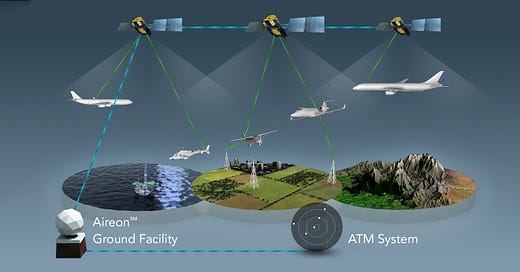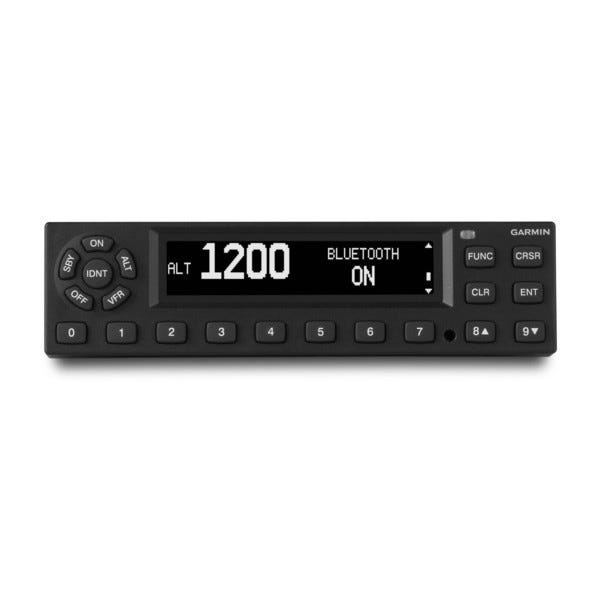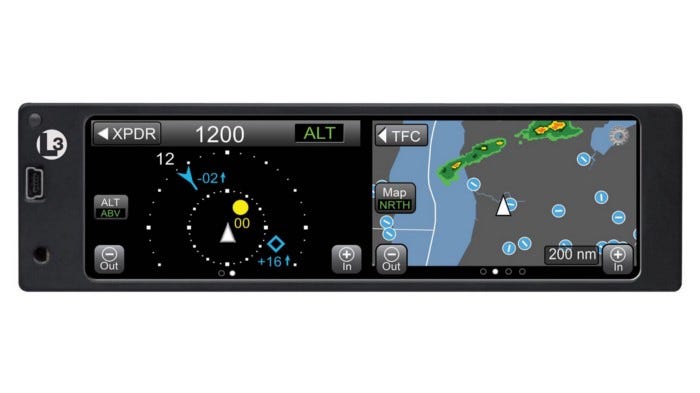ADS-B in Canada, What Recreational Pilots Need to Know
What is it
Automatic Dependent Surveillance-Broadcast (ADS-B) is a satellite-based aircraft tracking system. Think of Air Traffic Control (ATC) radar, but with satellites.
ADS-B will phase out radar as the primary aircraft tracking system. In addition, there are other advantages over radar. First is safety, allowing a more detailed tracking system for ATC to monitor aircraft.
Pilots can enjoy improved situational awareness from the optional ADS-B IN. ADS-B IN, provides altitude, heading, distance, and other information on aircraft in their vicinity. Other benefits include weather, for Universal Access Transceiver (UAT), ADS-B IN equipped aircraft. This provides weather overlay and radar information in the flight deck. Flight Information Service — Broadcast (FIS-B) is also available, which provides pilots with flight information such as NOTAMs.
Finally, the cost of the ADS-B system is less than the operation and ongoing maintenance costs of the old ground-based radar system
How does it work
The United States uses over 600 ground stations to monitor aircraft overhead and relay this information. In contrast, Nav Canada has implemented the use of a space-based ADS-B system by becoming a leader in the Aireon air traffic surveillance system. This system uses the Iridium NEXT constellation of 66 satellites. While there are many reasons for this decision, the vast geography of Canada and the responsibility of covering the North Atlantic routes were contributors to Nav Canadas’ decision.
The Nav Canada ADS-B system is currently in operation over Hudson Bay and the North Atlantic routes, historically challenging areas for ATC as ground base radar cannot cover these areas. In addition, aircraft operating above 29,000 feet are monitored via ADS-B and must be properly equipped.
To test and improve the widespread implementation of the ADS-B system, Nav Canada has been offering ADS-B services to aircraft in the Montreal Flight Information Region (FIR), which are appropriately equipped and operating below 29,000 feet. This service is planned to be expanded to the Winnipeg and Edmonton FLR before the end of 2022.
Beyond these areas, Nav Canada has announced a phased approach to further implementation of the ADS-B system. Phase 1, which begins February 23, 2023, will require all aircraft operating in Class A airspace, (18,000 feet and up) and in Class B airspace, (12,500–17,999 feet) to be appropriately equipped for ADS-B monitoring. Phase two will include Class C, D, and E airspace. This is the phase which will cover most of the small private and recreational aircraft in Canada. While no firm date for phase two has been announced, Nav Canada has stated that it would not occur before 2026 to allow time for operating improvements within the system, and for aircraft to be properly equipped to meet the mandate.
ADS-B Out vs ADS-B In
You will have heard of ADS-B Out, which is required in the mandate, but what is it and what then is ADS-B In?
ADS-B Out is simply the signal an appropriately equipped aircraft sends, out. This signal contains the required information, such as identification, altitude, and direction. ADS-B, just like Mode S transponders, can send additional aircraft-specific information such as registration and type of aircraft. This information is transmitted to ATC as well as other aircraft that are equipped with ADS-B In.
To understand ADS-B In, imagine your ADS-B equipment can act like your own ATC radar screen which can display other appropriately equipped aircraft that are transmitting their ADS-B out, information. Your display, whether it be an Multi Function Display (MFD) or panel display as part of your ADS-B install, will be able to provide information, similar to what ATC receives from other aircraft. For anyone who has flown with a Traffic Collision Avoidance System (TCAS), ADS-B In is similar, but with additional functions.
1090 vs 978
Today Mode S transponders, commonly installed on complex and larger aircraft, operate on the 1090 MHz frequency. As this is how transponders “talk” to each other, and ATC, it makes sense to stay with this frequency for the ADS-B system.
Policymakers in the United States became concerned that installing 1090 MHz transponders on almost every aircraft in the United States would overwhelm the frequency. Causing the transponder equivalent of being stepped on when talking to ATC. To alleviate this, they designated the second frequency of 978 MHz. This second frequency is reserved for smaller, general-aviation-type aircraft that previously did not require a Mode S level transponder. This also allowed the creation of smaller, more cost-effective equipment to be created for the recreational aircraft market.
Canada has only a fraction of the aircraft population the United States has and considering all the larger domestic and Trans-Atlantic traffic, as well as most international traffic, currently operate on 1090, Nav Canada opted to stay with the single 1090 MHz frequency for its ADS-B requirement. Therefore, aircraft equipped with only 978MHz ADS-B out equipment do not meet the current and future Nav Canada requirements.
Ground vs Space-Based System
As mentioned earlier, the US opted for a ground-based system, comprising hundreds of ground stations to transmit and receive ADS-B information. Due to the large, unpopulated areas within and near Canadian airspace, a completely ground bases system is not practical, and Nav Canada opted for a space-based system. Due to this, the Canadian ADS-B mandate requires aircraft to have antenna diversity. Antenna diversity means there is a top-mounted antenna and a bottom-mounted antenna. This allows an aircraft to speak to all stations, ground or space based.
Options
Currently, there are only a few options for diversity transponders. The Garmin GTX 335D (ADS-B Out only) and 345D (in & out), the L-3 Lynx NGT-9000D+, are both diversity, panel-mounted options for your aircraft. They both have some great features and connectivity options, but they come at a price, both models are easily in the $10,000 plus price range, plus installation. This means they are priced out of the reach of many small aircraft owners.
Another option is the uAvionix tailBeaconX. The tailBeaconX mounts in place of an aircraft’s rear navigation light. It incorporates its own LED white taillight as well as an upward and downward-facing antenna to meet the diversity requirement without additional installation requirements. It does require either the AV-20 or AV-30 MFD to operate. When paired with an AV-30, the cost is a more reasonable $5500 range.
Final Thoughts
From all this mandate talk, it is easy to believe that ADS-B will become a requirement for any aircraft flying in Canada, but this is not the case. Looking back to the FAA, they require ADS-B out within certain airspace. ADS-B In, is merely an option for owners and pilots to decide if they want it.
During the years leading up to the FAA mandate, they widely advertised the requirement and January 1, 2020, deadline, even offering a $500 rebate incentive for owners to equip. For these reasons, it is often assumed that ADS-B out is required to fly everywhere in the US, but that is not the case.
The FAA requirement is as follows.
Class A, B, and C airspace.
Class E airspace at or above 10,000 feet MSL, excluding airspace at and below 2,500 feet AGL
Within 30 nautical miles of a Class B primary airport (the Mode C veil)
Above the ceiling and within the lateral boundaries of Class B or Class C airspace up to 10,000 feet.
Class E airspace over the Gulf of Mexico, at and above 3,000 feet MSL, within 12 nm of the U.S. coast.
This means non-ADS-B-equipped aircraft can fly within US airspace, so long as they avoid the mandated areas. Canada will likely be the same. Nav Canada’s proposed mandate does not currently cover Class G, uncontrolled airspace. As Class G covers a large portion of Canada, there will be cases where ADS-B compliance will not be required for some aircraft. Most owners though, will need, or want, to fly within Class C, D, or E airspace and therefore will need to be properly equipped.
While the complete mandate is still a few years away, there is optimism that more reasonably priced options will become available. Regardless of that happening, the mandate will arrive and we, as aircraft owners, must plan and prepare accordingly. This change is ultimately one of safety, as our world changes and the possibility of more aircraft, as well as new aircraft, such as Unmanned Aerial Systems, enter the airspace, technology such as ADS-B will keep our skies safe for us to enjoy for years to come.
On August 2, 2022 Nav Canada amended their implementation dates as follows
the mandate will come into effect:
Class A Canadian airspace on August 10, 2023
Class B Canadian airspace on May 16, 2024
Class C, D and E to occur no sooner than 2026 and will be determined pending further assessment.












